Phil Giunta's Blog, page 18
January 11, 2021
Weathering the “Perfect Storm”
January 10, 2021
Book Review: A Thousand Degrees Below Zero by Murray Leinster
 In the middle of summer, an ice floe materializes in New York harbor, leaving two ships in distress. During the ensuing confusion, a strange black aircraft descends and hovers over the scene before vanishing as quickly as it appeared. Shortly after, several more ice “cakes” form without warning in the Straits of Gibraltar, Folkestone Harbor, and Yokohama.
In the middle of summer, an ice floe materializes in New York harbor, leaving two ships in distress. During the ensuing confusion, a strange black aircraft descends and hovers over the scene before vanishing as quickly as it appeared. Shortly after, several more ice “cakes” form without warning in the Straits of Gibraltar, Folkestone Harbor, and Yokohama.
With panic mounting across the globe, a manifesto is sent to the British government from a man named Wladislaw Varrhus, who announces his intention to assume control of all world governments and establish himself as dictator. If the nations fail to meet his demands, more waterways will be frozen, disrupting commerce.
The American military consults with one Professor Hawkins and his assistant Teddy Gerrod, who develop a method to neutralize Varrhus’s “cold bombs”—but the deranged inventor is not so easily foiled. He not only returns with an improved version of his cold bomb, but murders Professor Hawkins in revenge. With the help of the professor’s daughter, Evelyn, and an American pilot named Davis, Teddy devises a plan to defeat Varrhus.
A Thousand Degrees Below Zero was Murray Leinster’s (William Fitzgerald Jenkins) first published novella, featured in the July 1919 edition of The Thrill Book pulp magazine. It’s a typical Leinster story with two-dimensional protagonists and a plot that relies heavily on the science and technology of the time with inventive twists. A fun science fiction adventure tale that would make an enjoyable TV movie.
December 28, 2020
Book Review: Philip Jose Farmer’s Night of Light
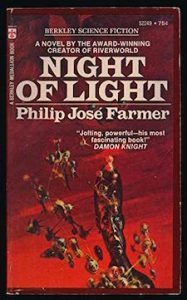 After fleeing Earth to the planet Kareen, thief and murderer John Carmody is taken in by two Catholic missionaries who order him on a covert fact-finding mission to the Temple of Boonta on the eve of an annual ritual known as the Night of Light.
After fleeing Earth to the planet Kareen, thief and murderer John Carmody is taken in by two Catholic missionaries who order him on a covert fact-finding mission to the Temple of Boonta on the eve of an annual ritual known as the Night of Light.
Most Kareenans take sedatives to ensure that they sleep during the chaotic and savage Night. To remain awake is to be subjected to torturous hallucinations, to lose one’s sanity, and potentially, to be murdered or commit suicide.
Fearless and irreverent, Carmody mocks all religions, until he defies regulations and remains awake during the Night in an attempt to assassinate a god incarnate named Yess. According to Kareenan beliefs, the goddess Boonta has two sons, the benevolent Yess and the evil Algul, each of whom are reborn through the ages and take turns ruling Kareen.
As me makes his way through the streets to the temple where Yess has concealed himself for the Night, Carmody is confronted by bizarre, disturbing visions that eventually compel him to renounce his old life and convert to Catholicism.
Years later, after returning to Earth and undergoing rehabilitation, Carmody enters the priesthood and is ordered by the Church to return to Kareen and dissuade the latest incarnation of Yess from sending missionaries to spread Boontism to other worlds. However, vestiges of Carmody’s old life reemerge as the Night of Light is once again nearly upon Kareen…
Strong in both plot and character arc, Night of Light is yet another captivating, original, and wildly imaginative example of Philip Jose Farmer’s propensity for using science fiction as a milieu to explore and question long-established religious beliefs. This is also evidenced by some of his other works, such as Inside Outside and the Riverworld series.
December 26, 2020
Goodbye, Dolle’s?
Over the past four years, I wrote a few short stories set in Rehoboth. Three were published by Cat & Mouse Press (based in Lewes, DE). “Tower Sixteen” took second place in the Rehoboth Beach Reads contest in 2016 and was included in the anthology BEACH NIGHTS . In 2019, my stories “Tapestry” and “The Celestials” were published in BEACH PULP .
 Photo by Phil Giunta (July 2011).
Photo by Phil Giunta (July 2011).Just before Christmas, the news broke that Dolle’s Salt Water Taffy would be leaving their current location on the corner of the boardwalk and Rehoboth Avenue when their lease expires on January 31. Although relatively minor, this is yet another disappointing development in 2020. I hope they find a way to keep the iconic Dolle’s sign on display either in its current location or at another prominent site along the boardwalk or Rehoboth Avenue.
While Dolle’s is relocating only three doors away to merge with Ibach’s By The Sea (both shops are owned by the Tom Ibach), other landmark businesses, such as Nicola’s Pizza and The Pond, are moving out of downtown to Route 1. Change is inevitable, but I hope this does not become a trend.
December 23, 2020
About This Writing Stuff
In our final edition of About This Writing Stuff for 2020, Ken Brosky offers advice for managing multiple narrators while Abigail Perry helps us decide when our story can support two protagonists.
Even as an inveterate plotter, I admit that Hank Phillippi Ryan makes a strong case for writing without an outline (aka pantsing, but I like her use of “emergent design”).
In the Kill Zone, Sue Coletta provides insightful tips for crafting a series bible while James Scott Bell shows us three ways to weave humor into our stories. Over at Mythcreants, Oren Ashkenazi discusses how to handle content edits and Chris Winkle suggests clever ways to describe your POV character.
If you’re considering self-publishing, I encourage you to take some pointers from Anne R. Allen, and if you’re struggling to find that powerful opening to your story, let Josyln Chase help.
All that and a lot more. Enjoy… and Happy Holidays!
How to Effectively Manage Multiple Narrators in Your Novel by Ken Brosky via Jane Friedman
5 Tell-Tale Signs of an Amateur Self-Published Book by Anne R. Allen
How to Write Without an Outline by Hank Phillippi Ryan
Productive Procrastination: Re-Purposing Downtime to Profitably Promote by Ellen Byron
6 Tips to Help You Network Like a Natural by Penny Sansevieri
Tips to Create a Series Bible by Sue Coletta
On Using Humor in Fiction by James Scott Bell
Five Things to Know When You Get Content Editing by Oren Ashkenazi
Nine Ways to Describe Your Viewpoint Character by Chris Winkle
Staging the Scene by John J. Kelley
The Secret for Creating Characters that Readers Want to Root For by J.D. Edwin
Can You Have More Than One Protagonist in Your Story? by Abigail Perry
How to Start Your Story: 10 Ways to Get Your Story off to a Great Start by Joslyn Chase
A Look at Literary Devices: What is Motif? by Sherry Howard
How a Limited vs. Tight Point of View Can Confuse Writers by Janice Hardy
December 13, 2020
About This Writing Stuff
This week, James Scott Bell makes a good case for putting your protagonists between opposing characters, thereby forcing them to choose a path. Siera London introduces us to the BENP system of book marketing, and Daphne Gray-Grant links perfectionism with depression.
Richie Billing examines the use of religion in the fantasy genre, Joe Bunting provides a 20-step guide to novel writing, and Donald Maass teaches us to how dance to the beat (story beats, that is).
At Fiction University, we get schooled by Kassandra Lamb on the relationshp between backstory and behavior, Chris Eboch explains the importance of plot questions, and Janice Hardy offers advice about planting clues in your story.
All that and a lot more. Enjoy and Happy Holidays!
Religion in Fantasy by Richie Billing
What Kind of Marketing Plan Will Work for Us? by Siera London via Jami Gold
Put Your Lead Between Opposite Characters by James Scott Bell
How to Choose Scenes for Your Story by Chris Winkle
What is DRM (Digital Rights Management)? by Matt Knight at Sidebar Saturdays
Show Me the Money: Royalties, Rights, and Riches for Indie Authors by Erika Liodice
The Beat Goes On by Donald Maass
How to Write a Novel (Without Fail) by Joe Bunting
How to Sneak Clues Past Your Readers and Keep Them Guessing by Janice Hardy
Writing a Page-Turner: Keep the Reader Guessing with Story Questions by Chris Eboch
The Importance of Backstory (or How the Brain Connects the Present to the Past) by Kassandra Lamb
Is Your Depression Masquerading as Perfectionism? by Daphne Gray-Grant
11 Ways to Give Writing Perfectionism the Heave-Ho by Daphne Gray-Grant
60 Things For Your Character to Do When They Talk or Think by Amanda Patterson
December 1, 2020
Book Review: The Wailing Asteroid by Murray Leinster
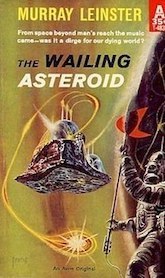 A signal from outer space reaches Earth and is broadcast over the radio, interrupting Joe Burke just as he is about to propose to his secretary and longtime friend, Sandy Lund. As it turns out, the signal is comprised of sounds resembling those of a flute. They are eerily familiar to Burke from a recurring dream he had as a child after his uncle gifted him with a number of relics found in a Cro-Magnon cave.
A signal from outer space reaches Earth and is broadcast over the radio, interrupting Joe Burke just as he is about to propose to his secretary and longtime friend, Sandy Lund. As it turns out, the signal is comprised of sounds resembling those of a flute. They are eerily familiar to Burke from a recurring dream he had as a child after his uncle gifted him with a number of relics found in a Cro-Magnon cave.
Though disappointed, Sandy returns to Burke’s engineering office where he plays a recording he made of the sounds years before and they are an exact match to those from space. Soon after, astronomers identify the source of the signal as an asteroid on a course that will bring it close to Earth.
Without sufficient evidence, the United States and Russia interpret the signals as a threat. The two major powers compete, and fail, to send a craft to the meet the aliens. However, Burke designs and constructs a small ship with the assistance of a yacht builder named Holmes and a taciturn electronics expert named Keller. Sandy’s sister Pam joins the team to assist with tracking orders and receiving shipments.
Early in their testing of a reactionless drive, an explosive mishap draws the attention of a reporter, two government agents, and the police. Burke tries to persuade them that he is building an advanced bomb shelter. They are not convinced and suspect Burke and company of conspiring with the aliens. A few days later, the police return to arrest them, but Burke launches the ship with Holmes, Keller, and the Lund sisters aboard.
A week and a half later, they reach the asteroid and fly the ship through a tunnel, which closes behind them. Lights, breathable air, and an artifcial gravity system are activated, allowing the intrepid voyagers to leave the ship. To their dismay, they find the asteroid devoid of life.
Burke and his team explore the interior and learn that it is a garrison, long abandoned by its troops. They also interpret the flute-like signal as a beacon ordering the ancient soldiers to return in order to defend against an approaching enemy. Who were the soldiers and where did they go? More importantly, can Burke and company learn how to operate the garrison in time to defend Earth against this powerful and unknown threat from interstellar space?
If you can ignore Leinster’s cardboard characterizations—such as the whiny and emotionally clueless Burke and the stereotypical capricious, husband-hunting women—The Wailing Asteroid is an enjoyable light-hearted adventure with a healthy dose of plausible 1960s science and engineering.
November 27, 2020
Book Review: Inside Outside by Philip Jose Farmer
Humans and demons living together? What’s Hell coming to?
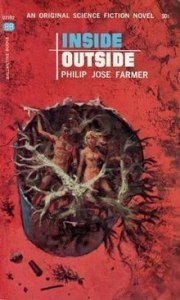 Jack Cull is one of the millions of humans resurrected from the dead only to live on a dry blistering world where the sun never sets. Is this truly Hell or merely Purgatory? Whatever it is, one this is certain, the place isn’t supernatural. The denizens, whether human or “demon” are biological and the planet itself unstable and prone to earthquakes as it expands to accommodate new arrivals.
Jack Cull is one of the millions of humans resurrected from the dead only to live on a dry blistering world where the sun never sets. Is this truly Hell or merely Purgatory? Whatever it is, one this is certain, the place isn’t supernatural. The denizens, whether human or “demon” are biological and the planet itself unstable and prone to earthquakes as it expands to accommodate new arrivals.
While on duty at the Information Exchange, Jack receives a call from a contact claiming that a man named Fyodor has evidence that Jesus Christ himself, known as “X” on this world, never left Hell after he was crucified, but is still here working to save souls and help them escape. Jack is given permission to leave his post and meet with Fyodor to confirm the story. On his way out, he encounters an old flame, Phyllis Nilstrom, a gold-digging opportunist who left Jack when someone of higher rank in the Exchange became available. That someone happens to be Jack’s supervisor.
As it turns out, Phyllis is traveling to the same sector where Jack is scheduled to meet with Fyodor. As such, Jack is tasked with ensuring her safety.
Shortly after meeting with Fyodor at an outdoor café, a riot ensues in the street, leaving two men dead. An ambulance arrives, from which steps “X” himself! He assists in loading the victims into the ambulance presumably to take them to a place where they will be resurrected once more. However, the mob attacks the ambulance crew and “X” is decapitated. Fyodor is at first devastated, then enraged when a demon confiscates Christ’s head and disappears into a manhole.
Fyodor and Cull pursue the creature, but not before a second group of rioters arrive, pursuing several members of the Exchange—including Phyllis! She joins Cull and Fyodor in a wild and perilous expedition through the sewers and tunnels of Hell in search of answers about the origins of this world and the true identity of “X.”
With its concept of continuous resurrection of the dead on an alien world, Inside Outside seems to be a precursor to Philip José Farmer’s 1971 masterpiece, To Your Scattered Bodies Go, the first book in his acclaimed Riverworld series.
While there is almost no character development here, Farmer builds his world slowly at first, presenting details as the story unfolds until the trio enters the sewer. After that, the pacing ramps up to breakneck speed in one of the most bizarre and imaginative twists on Judeo-Christian beliefs.
November 21, 2020
Book Review: My Friend Jackson by Christopher D. Ochs
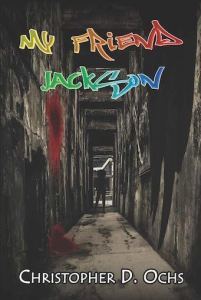 After moving out of the Projects and into an apartment building in a slightly less dangerous part of town, high school student Jasmine Price and her mother befriend an elderly neighbor, Mrs. Fieldings.
After moving out of the Projects and into an apartment building in a slightly less dangerous part of town, high school student Jasmine Price and her mother befriend an elderly neighbor, Mrs. Fieldings.
While her mother works two jobs—and her father is serving overseas in the Army—Jasmine often spends time after school in the company of Mrs. Fieldings, who becomes her surrogate grandmother. As their friendship blossoms, Jasmine comes to call her “Bibi,” a term of respect and endearment.
The move also includes a transfer to a new high school, where Jasmine becomes the target of bullying and intimidation, mostly by her fellow players on the girls’ basketball team.
A short time after the first incident at school, Bibi introduces Jasmine to her three-horned Jackson’s chameleon named Mlinzi. The lizard’s colors change during the encounter, indicating an immediate trust and affection for Jasmine. Noting this, Bibi gifts the chameleon to Jasmine, who renames him Jackson.
Meanwhile, the baseless hatred toward Jasmine escalates at school until she is cornered in an alley by the basketball team’s captain, Nevaeh, who accuses Jasmine of making a play for her boyfriend. It becomes clear that Nevaeh intends to kill Jasmine—until something preternatural intercedes…
Christopher Ochs masterfully introduces all the key players in medias res and maintains steady tension throughout this believable tale of girl-on-girl bullying in an urban public school. There are scenes in which the dialogue among the teenagers is more mature than expected, given their callow and puerile behavior in other parts of the story. However, Jasmine’s brief transformation from prey to predator as a result of her relationship to the creature is well crafted. I applaud the portrayal of Jasmine’s mother as a harried, and mostly absent, mother struggling to make ends meet while dealing with her daughter’s deteriorating situation and fretting about her husband after he is wounded in the line of duty in Afghanistan. Overall, the blending of the harsh realities of inner city life with the fantastical elements of a unique monster story is both seamless and subtle.
November 15, 2020
Book Review: The Green Odyssey by Philip Jose Farmer
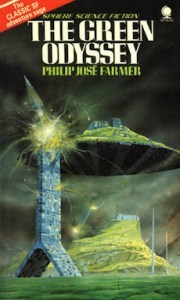 After crash landing on a primitive and barbaric planet, Earth astronaut Alan Green becomes a slave to the Duke of Tropat and paramour to the duke’s termagant wife, all while married to a gorgeous slave woman named Amra. Green has one daughter with Amra, but her other three children are each from different “owners” who bought and sold her over the years.
After crash landing on a primitive and barbaric planet, Earth astronaut Alan Green becomes a slave to the Duke of Tropat and paramour to the duke’s termagant wife, all while married to a gorgeous slave woman named Amra. Green has one daughter with Amra, but her other three children are each from different “owners” who bought and sold her over the years.
When Green learns that two Earthmen recently landed near the distant city of Estorya and were taken prisoner as “demons,” he strikes a deal with a trader, Miran, to hide aboard his ship on his next voyage across the vast, grassy plain of Xurdimur. For on this world, boats travel not only by sea, but also over land using a series of large wheels.
It is Green’s plan to free the imprisoned Earthmen before they are executed during an upcoming festival, then return with them to Earth aboard their ship.
After a perilous escape from the duke and duchess, Green disguises himself as a monk and boards Miran’s ship—only to be confronted by Amra and her children, who he had planned to leave behind for they would never be able to adapt to life on Earth.
During their trek across Xurdimur, Miran cleverly evades an attack by pirates, but a day or two later, his ship collides with one of the fabled roaming islands that levitate across the plains of their own volition. Many of Miran’s crew are killed in the crash. Most of the survivors are slaughtered shortly after by the savage cannibals inhabiting the island. Although wounded, Green evades capture, but is separated from Amra and the children. He soon learns that they were imprisoned by the natives.
No sooner does he rescue them than Green encounters a disheveled Miran who also survived the collision. In the middle of the night, they manage to steal a smaller boat from the island and continue across the plain to Estorya. Will Green be able to liberate his fellow Earthmen before Miran betrays him to the authorities? Will their ship be undamaged and able to depart this godforsaken world and if so, will there be enough room for Amra and the children?
The Green Odyssey was Philip José Farmer’s first novel-length publication and is more fantasy-adventure than science fiction. While the setting has a few unique elements, the characters are two-dimensional. Overall, the story is reminiscent of the Barsoom novels of Edgar Rice Burroughs and seemed to be a precursor to Jack Vance’s Planet of Adventure series in which an Earth astronaut named Adam Reith crash lands on a barbaric alien world named Tschai and after acquiring several companions, ventures off across the planet to find the means to return to Earth.



